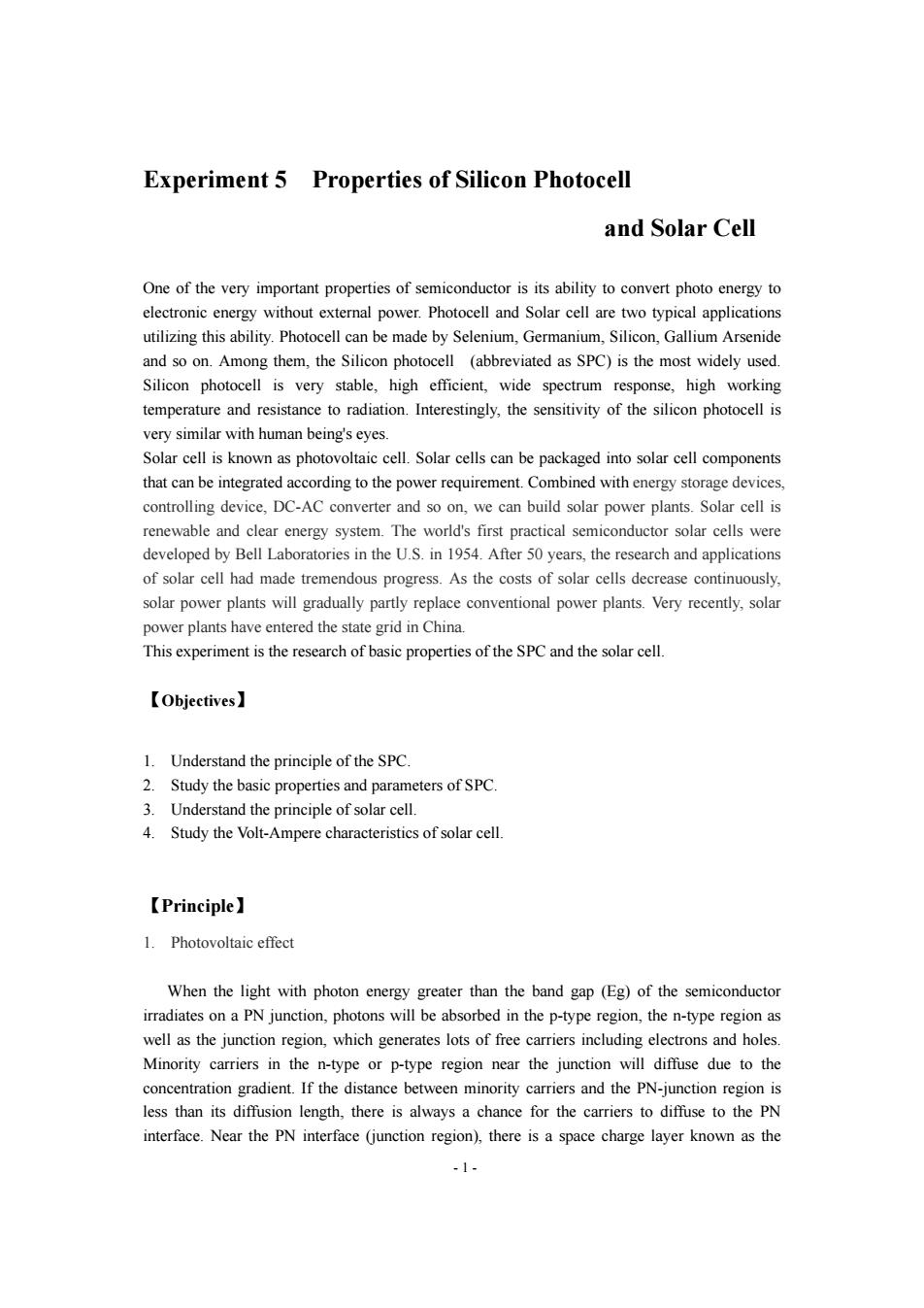正在加载图片...

Experiment 5 Properties of Silicon Photocell and Solar Cell One of the very important properties of semiconductor is its ability to convert photo energy to electronic energy without external power.Photocell and Solar cell are two typical applications utilizing this ability.Photocell can be made by Selenium,Germanium,Silicon,Gallium Arsenide and so on.Among them,the Silicon photocell (abbreviated as SPC)is the most widely used. Silicon photocell is very stable,high efficient,wide spectrum response,high working temperature and resistance to radiation.Interestingly,the sensitivity of the silicon photocell is very similar with human being's eyes. Solar cell is known as photovoltaic cell.Solar cells can be packaged into solar cell components that can be integrated according to the power requirement.Combined with energy storage devices, controlling device,DC-AC converter and so on,we can build solar power plants.Solar cell is renewable and clear energy system.The world's first practical semiconductor solar cells were developed by Bell Laboratories in the U.S.in 1954.After 50 years,the research and applications of solar cell had made tremendous progress.As the costs of solar cells decrease continuously, solar power plants will gradually partly replace conventional power plants.Very recently,solar power plants have entered the state grid in China. This experiment is the research of basic properties of the SPC and the solar cell. 【Objectives】. 1.Understand the principle of the SPC. 2.Study the basic properties and parameters of SPC. 3.Understand the principle of solar cell. 4.Study the Volt-Ampere characteristics of solar cell 【Principle】 1.Photovoltaic effect When the light with photon energy greater than the band gap(Eg)of the semiconductor irradiates on a PN junction,photons will be absorbed in the p-type region,the n-type region as well as the junction region,which generates lots of free carriers including electrons and holes. Minority carriers in the n-type or p-type region near the junction will diffuse due to the concentration gradient.If the distance between minority carriers and the PN-junction region is less than its diffusion length,there is always a chance for the carriers to diffuse to the PN interface.Near the PN interface (junction region),there is a space charge layer known as the -1-- 1 - Experiment 5 Properties of Silicon Photocell and Solar Cell One of the very important properties of semiconductor is its ability to convert photo energy to electronic energy without external power. Photocell and Solar cell are two typical applications utilizing this ability. Photocell can be made by Selenium, Germanium, Silicon, Gallium Arsenide and so on. Among them, the Silicon photocell (abbreviated as SPC) is the most widely used. Silicon photocell is very stable, high efficient, wide spectrum response, high working temperature and resistance to radiation. Interestingly, the sensitivity of the silicon photocell is very similar with human being's eyes. Solar cell is known as photovoltaic cell. Solar cells can be packaged into solar cell components that can be integrated according to the power requirement. Combined with energy storage devices, controlling device, DC-AC converter and so on, we can build solar power plants. Solar cell is renewable and clear energy system. The world's first practical semiconductor solar cells were developed by Bell Laboratories in the U.S. in 1954. After 50 years, the research and applications of solar cell had made tremendous progress. As the costs of solar cells decrease continuously, solar power plants will gradually partly replace conventional power plants. Very recently, solar power plants have entered the state grid in China. This experiment is the research of basic properties of the SPC and the solar cell. 【Objectives】 1. Understand the principle of the SPC. 2. Study the basic properties and parameters of SPC. 3. Understand the principle of solar cell. 4. Study the Volt-Ampere characteristics of solar cell. 【Principle】 1. Photovoltaic effect When the light with photon energy greater than the band gap (Eg) of the semiconductor irradiates on a PN junction, photons will be absorbed in the p-type region, the n-type region as well as the junction region, which generates lots of free carriers including electrons and holes. Minority carriers in the n-type or p-type region near the junction will diffuse due to the concentration gradient. If the distance between minority carriers and the PN-junction region is less than its diffusion length, there is always a chance for the carriers to diffuse to the PN interface. Near the PN interface (junction region), there is a space charge layer known as the